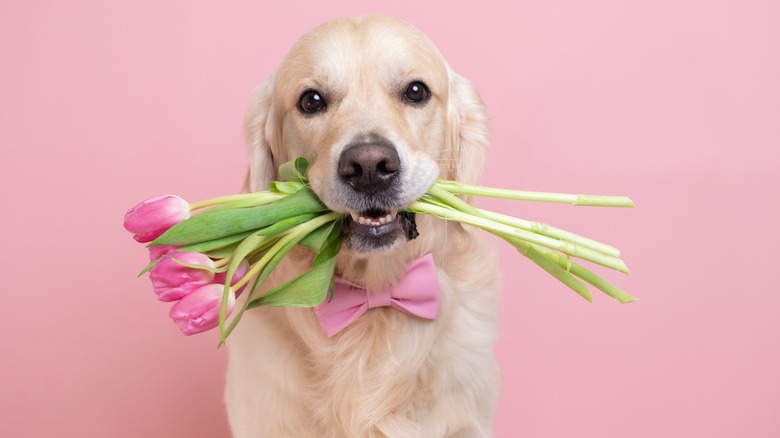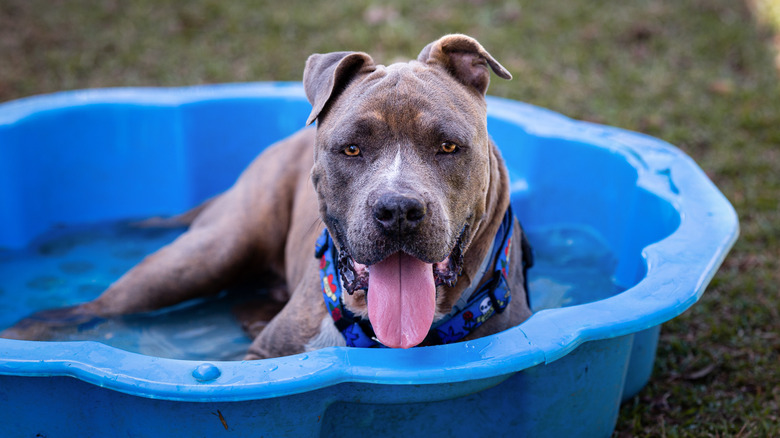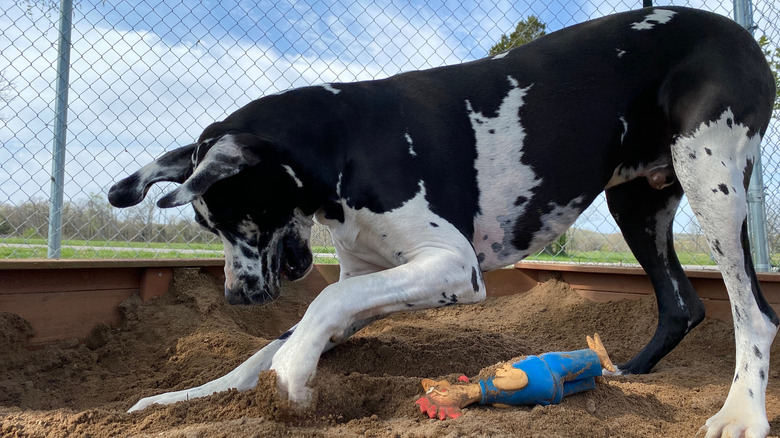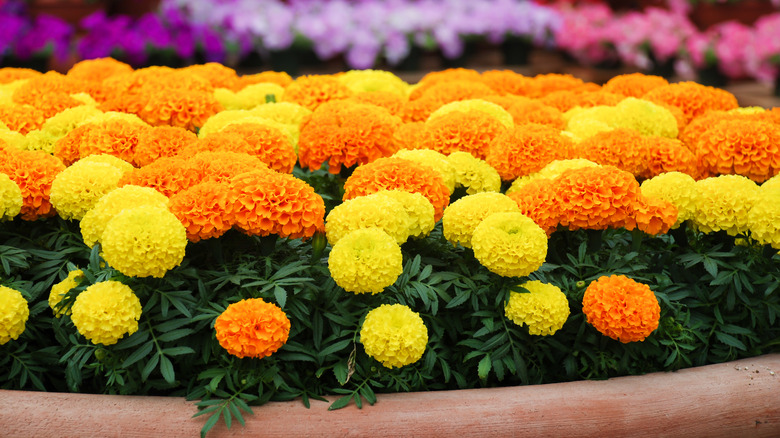Top 3 Tips On Creating A Dog-Friendly Yard
A lucky dog has a yard to romp around in. An even luckier one will also have its own play area complete with a pool or sandbox. A yard that is free of fleas is an extra perk for dogs and humans alike. Keeping your pet occupied, exercised, refreshingly cool and wet, and provided with a special space to sprawl out and dig in — all without those bothersome insects — is a canine dream come true. A dog-friendly yard is people-friendly too and good for your lawn and garden as well.
A pro-dog yard offers your pooch entertainment, comfort, and an outlet for energy in a safe and confined setting. Fido can be seen and monitored from a distance while maintaining its independence, per Dogo. Having a pool or sandbox to play in is an acceptable alternative to the dog destroying your flower bed or putting holes in your pristine lawn. Establishing a flea-free zone will not only work for the pet but also help to keep the pests away from the yard and out of your home.
A dog's perfect yard would have ample space with plenty of shade. Too much activity, especially in high humidity, can bring on heatstroke with a temperature exceeding 105 degrees, according to the American Kennel Club. A water bowl that won't tip over and paw-friendly surfaces are appreciated. Make sure there is an escape-proof fence and steer free of toxic plants.
Dog swimming pool
Your dog can enjoy a pool for as little as $20 and as much as several thousand. A simple kiddie one set a few inches into the ground is a good choice. Use hard plastic and avoid inflatable pools, which may fall victim to claws. Healthy Paws suggests circling it with a design of cinderblocks and sand. Ready-made pools set in cypress or other wood, some even bone-shaped or containing a fire hydrant, are available at much higher prices.
An appropriate pool size for the average dog is 5 feet long and 2.5 feet wide, says Acme Canine. They suggest making a doggie pool using plywood to make a box. Other supplies for the DIY project include nylon rope, a rubber mat, and a tarp or pool liner. A pump and filter can be used to equip a more deluxe pool.
Make sure the dog can get out of the pool at will. A ramp with a non-slip surface might be helpful. A bigger pool will be required if you have more than one animal. A dog toy or two can enhance the dog's experience. Having a dog pool might be a reason to invest in pet insurance. Also, contrary to popular belief, not all dogs can swim. Never throw one in the pool assuming it will begin to paddle. PetMD ranks retrievers as the best swimmers. Surprisingly, the giant Newfoundland is extremely skilled, though it might require an Olympic-sized pool.
Dog sandbox
Dogs dig because they are bored, want attention, are instinctively looking for prey, or seek protection, asserts the Humane Society. Little ones are the best diggers, with terriers crowned the champion. A digging dog desecrates one's yard. Grass and plants are ruined and the soil dries out. What better way to satisfy your pet's urges while protecting your yard than by offering your companion an alternate area for digging? A sandbox is a perfect solution.
Choose an area away from the garden and dig a pit up to a foot deep, per Lawn Love. It should be large enough to comfortably accommodate a reclining dog. Next, line the bottom and sides with a thin layer of fast-setting concrete, and create drainage holes. Fill with clean playground sand after it dries. Dampen the sand periodically. A comparable sandbox can be fashioned from wood with a liner underneath. A sand- or dirt-filled hole can also serve as an adequate sandbox. A plastic kiddie pool too. Cover the sandbox at night to thwart animal intruders.
The next step is to "assign" the sandbox to the dog. Bury familiar toys or favorite treats in the sand, Dogo instructs. Hide the lures on the surface initially. Encourage your friend to dig them out, then praise effusively when successful. Continue the process and vary the rewards. Soon the dog will consider the sandbox its own. If it is busted digging in forbidden areas, scold and then return it to the acceptable sandbox.
Flea-repelling plants
Fleas are not welcome in a dog-friendly yard. Fortunately, there is an extensive roster of flea-repelling plants to choose from. Many are toxic, warns Vulcan Termite & Pest Control, so be judicious when deciding which to use. Safe ones include catnip, chamomile, lavender, marigolds, mint, and rosemary. Think twice before planting citronella, eucalyptus, fleawort and fleabane, rue, and tansy.
The flea-repellers can be strategically placed on a porch or patio and can be used to guard entryways. Vulcan touts them as window plants, as the high-jumping flea can leap 7 inches off the ground.
Spraying essential oils on your dog is a proven way to keep it flea-free in your yard, recommends Jet Pet Resort, with the caveat to first have your vet okay the contents. The preferred choice is a 6:4 solution of apple cider vinegar and water, with a pinch of salt. One can also use a flea collar on a dog. Sunlight is anathema to fleas, who thrive in a dank environment. For the purpose of discouraging the insects, a dog-friendly yard should be well-trimmed and weeded frequently. It should be kept dry and free of damp lawn debris. Jet Pet Resort also gives a shout-out to the nematodes who eat fleas and help keep a yard dog-friendly.



